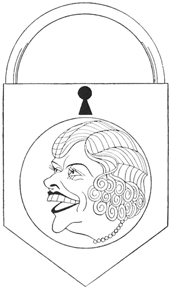SCHOOL FOR SCANDAL
Year: 2011
Past Paper: Season’s Greetings—Stop
We don’t view the Cladrite Era as the good ol’ days in the sense that we’re convinced life was better then than now. Different, sure, and it’s those differences that fascinate us. But better? In some ways, yes, but worse in others. We figure things tend to balance out over time. Every era has its highlights and low points.
But we do mourn the passing of certain practices and traditions, and high on that list is the telegram.
Truth be told, we’d give our eye teeth to be able to observe special occasions by sending telegrams. Sure, sure, email’s great, and Facebook, texting and Tweeting all have their place, but none possess the charm or carry the weight of a telegram. And while Christmas cards are a delight to send and receive, imagine sending Christmas telegrams!
We, alas, have never received a telegram, and we’ve sent only one, in 1984 (it never arrived, and to this day, we have no idea whether we were charged for it). But we perk right up any time we see a telegraph office or a telegram delivery depicted in an old movie. The practice and process of sending telegrams continues to fascinate us.
So we were very pleased to come across this promotional pamphlet for Postal Telegraph, Commercial Cables, and All-America Cables (were they all owned by the same concern? We assume so, but we don’t really know. If there are any telegraph experts reading this, by all means, please clue us in).
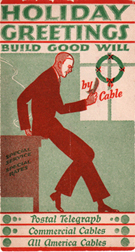 Hi-res view |
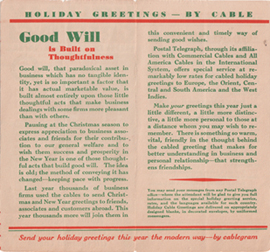 Hi-res view |
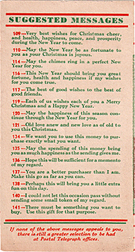 Hi-res view |
We like that telegrams are pitched in the pamphlet’s copy as the “modern way” to send holiday greetings, as the “convenient and timely way of sending good wishes.”
And we love the list of suggested messages on the back. We’d heard that one could order a pre-written telegram by the number, like an item on a menu at a Chinese restaurant, but we’d never seen a list of pre-composed messages and their accompanying numbers. Clearly one would hope to receive a telegram bearing one of the messages numbered from 134-141, since they were all intended to accompanied by wired money. Happy holidays, indeed!
A Cladrite holiday tradition continues
It’s that time of year again, folks.
Longtime readers will recall that the sharing of the B.C. Clark anniversary sale jingle is something of a holiday tradition here at Cladrite Radio. 2011 marks the third year we’ve shared it with you.
 Anyone who grew (or is currently growing) up in the Oklahoma City area knows that it’s just not the Christmas season until you’ve heard the B. C. Clark Christmas jingle on television or the radio at least once.
Anyone who grew (or is currently growing) up in the Oklahoma City area knows that it’s just not the Christmas season until you’ve heard the B. C. Clark Christmas jingle on television or the radio at least once.
Below are two versions of the jingle—the original, which is admittedly of lower audio quality, and a later version—the one currently heard on radio and TV in the Oklahoma City area—which arguably sounds a bit better, but drops one line late in the song (“The Christmas wish of B. C. Clark is to keep on pleasing you…”), because 30-second commercials had became the norm on local television.
B. C. Clark, for the non-Okies among you, is a jewelry retailer that’s been in operation in the Sooner State since 1892, and since 1956 (just one year outside Cladrite Radio’s purview, but we’re stretching a point for the holidays), they’ve been running the aforementioned jingle advertising their annual sale, which takes place not after Christmas, like most stores (or so the jingle’s lyrics insist), but just before.
So for 55 years, denizens of central Oklahoma have been humming along to this catchy ditty, and it’s now our pleasure to share this holiday highlight with folks from other parts of the country (and around the world).
Ms. Cladrite, who grew up in New Jersey, has the darned thing memorized after just three or four Christmas seasons’ exposure to this seasonal delight and can sing along whenever it’s played.
It’s just that catchy a tune.
But be forewarned — listen more than two or three times, and you’ll be hooked, no matter how far away you live from the nearest B.C. Clark location. And soon, as with the millions of Okies who have come to associate this venerable jingle with the Christmas season, you’ll come to feel that it just isn’t the holidays until you’ve heard the jingle once or twice (or a dozen times).
Times Square Tintypes: Tex Guinan
“GIVE THIS LITTLE GIRL A GREAT BIG HANDCUFF”
Christmas by the book
Does any major holiday inspire the sort of nostalgia that Christmas fosters for so many? Yes, we chuckle to ourselves when remembering the dime-store Valentines we distributed to our classmates back in the day, and we recall with guilty fondness the mayhem we used to cause when playing with fireworks on Independence Day. Halloween inspires recollections of trick-or-treating, and Thanksgiving certainly yields its share of special memories,
But Christmas stands alone, in our considered opinion.
Apparently, author Susan Waggoner agrees with us. She’s built something of a cottage industry around books that celebrate Christmas past and present (but mostly past), and she’s not published just one or two but four such books, each as delightful and engaging as the last.
It’s a Wonderful Christmas: The Best of the Holidays 1940-1965 (2004) recalls Christmas as it was celebrated during World War II and the years after, a period many people consider the “golden age” of Christmas. Under the Tree: The Toys and Treats That Made Christmas Special, 1930-1970 (2007) revisits the must-have kids’ gifts of years gone by, while Christmas Memories: Gifts, Activities, Fads, and Fancies, 1920s-1960s (2009) traces the evolution of Christmas practices and traditions with the passing of the decades.
Waggoner’s latest, the recently released Have Yourself a Very Vintage Christmas, examines the crafts, decorating practices and food that were so key to Christmas from the 1920s through the ’60s.
 |
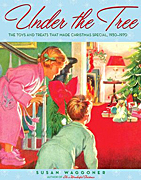 |
 |
 |
All four volumes are chock full of vintage graphics, and they’re loaded with plenty of holiday trivia we’re betting you don’t know.
For instance, did you know that:
- In 1900, only one in five American families had a Christmas tree.
- Until the 1920s, Christmas cards were generally postcards, not the folding cards used today.
- It was Gimbel’s, not Macy’s, who threw the first Thanksgiving Day parade—in 1920. (The first Macy’s parade was in 1924.)
- Mr. Potato Head was the first toy ever advertised on television—in 1952.
- The Sock Monkey was born in the 1920s when Nelson Knitting Mills started putting a bright red heel on their brown and white work socks. Some crafter came up with the idea for the familiar stuffed monkey, and it wasn’t long before Nelson began including instructions for making the monkeys with every pair of socks sold.
No, of course you didn’t know that, and neither did we (well, we know about the origins of the Macy’s parade, but not about Gimbel’s beating them to the punch!)
Any of these four volumes would make a great Christmas present for anyone who loves this season, and—perhaps even better—delightful host/hostess gifts to bring to those holiday parties that await you later in the month.
What’s more, we’re pleased to announce that Waggoner will be a guest blogger here at Cladrite Radio in a few days. We’re very excited about that, as we know she’ll share some very interesting stories about Christmas as it was celebrated in the earlier decades of the 20th century.
So check back—you won’t want to miss this.


